
The Royal Norwegian Navy is the branch of the Norwegian Armed Forces responsible for naval operations of Norway. As of 2008, the Royal Norwegian Navy consists of approximately 3,700 personnel and 70 vessels, including 4 heavy frigates, 6 submarines, 14 patrol boats, 4 minesweepers, 4 minehunters, 1 mine detection vessel, 4 support vessels and 2 training vessels. It also includes the Coast Guard.

The Type 23 frigate or Duke class is a class of frigates built for the United Kingdom's Royal Navy. The ships are named after British Dukes, thus leading to the class being commonly known as the Duke class. The first Type 23, HMS Norfolk, was commissioned in 1989, and the sixteenth, HMS St Albans was commissioned in June 2002. They form the core of the Royal Navy's destroyer and frigate fleet and serve alongside the Type 45 destroyers. They were designed for anti-submarine warfare, but have been used for a range of uses. Twelve Type 23 frigates remain in service with the Royal Navy, with three vessels having been sold to the Chilean Navy, and one being retired in 2021.
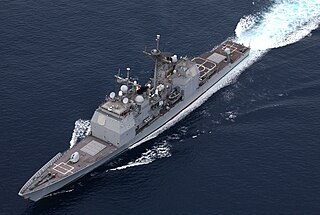
The Aegis Combat System is an American integrated naval weapons system developed by the Missile and Surface Radar Division of RCA, and it is now produced by Lockheed Martin.
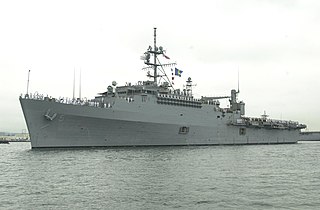
USS Ogden (LPD-5), an Austin-class amphibious transport dock, was the second ship of the United States Navy to be named for Ogden, Utah. Ogden was laid down on 4 February 1963 by the New York Naval Shipyard. She was launched on 27 June 1964 sponsored by Mrs. Laurence J. Burton, and commissioned at New York City on 19 June 1965.

The littoral combat ship (LCS) is either of two classes of relatively small surface vessels designed for operations near shore by the United States Navy. It was "envisioned to be a networked, agile, stealthy surface combatant capable of defeating anti-access and asymmetric threats in the littorals". Littoral combat ships are comparable to corvettes found in other navies.

The Fridtjof Nansen-class frigates are a class of frigates that are the main surface combatant units of the Royal Norwegian Navy. The ships are named after famous Norwegian explorers, with the lead ship of the class bearing the name of Fridtjof Nansen, the Norwegian scientist, explorer and humanitarian. Five ships were ordered from Spanish shipbuilder Bazan.

The Oslo-class frigate is a Royal Norwegian Navy frigate design of the 1960s, based on the US Navy Dealey-class destroyer escorts. The forward hull was customized to suit Norwegian sea conditions better and several sub-systems were European built. Ships of the class operated until 2007, when they were replaced by the Fridtjof Nansen class.

Skjold-class corvettes are a class of six light, superfast, stealth missile corvettes in service with the Royal Norwegian Navy. The boats were formerly classed as MTBs but, from 2009, the Royal Norwegian Navy has described them as corvettes (korvett) because their seaworthiness is seen as comparable to corvettes, and because they do not carry torpedoes. They were built at the Umoe Mandal yard. With a maximum speed of 60 knots (110 km/h), the Skjold-class corvettes were the fastest combat ships afloat at the time of their introduction.

HNoMS Fridtjof Nansen is a frigate of the Royal Norwegian Navy. Launched on 5 April 2006, she is the lead ship of the Fridtjof Nansen class of warships.

Chevalier Paul is a Horizon-class frigate of the French Marine Nationale commissioned in June 2009, the third vessel of the French Navy named after the 17th century admiral Chevalier Paul. The main mission of this type of ship is the escort and protection of a carrier strike group formed around an aircraft carrier, usually Charles de Gaulle or one of the aircraft carriers of the US Navy, or an amphibious operation carried out by amphibious helicopter carriers. The ship's specialty is air traffic control in a war zone, but it can be employed in a wide variety of missions, such as intelligence-gathering, special forces operations, or in protecting less well-armed vessels. Horizon-class frigates such as Chevalier Paul are the most powerful surface combatants that France has ever built. In service since the end of 2011, it bears the pennant number D621. Its namesake is Jean-Paul de Saumeur, better known as Chevalier Paul, a French naval officer born in Marseille in 1598.

HNoMS Helge Ingstad was a Fridtjof Nansen-class frigate of the Royal Norwegian Navy. The vessel was ordered on 23 June 2000 and constructed by Navantia in Spain. The ship was launched on 23 November 2007 and commissioned on 29 November 2009. Named for Helge Ingstad, a Norwegian explorer, the Fridtjof Nansen class are capable of anti-air, anti-submarine and surface warfare. On 8 November 2018, HNoMS Helge Ingstad was in collision with the tanker Sola TS in Norwegian waters just outside Sture Terminal. Helge Ingstad was severely damaged in the collision and beached. On 13 November 2018, the ship sank where she had run aground and became a constructive total loss.
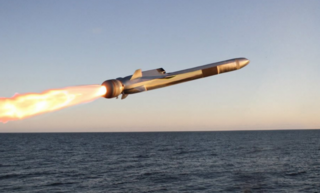
The Naval Strike Missile (NSM) is an anti-ship and land-attack missile developed by the Norwegian company Kongsberg Defence & Aerospace (KDA).
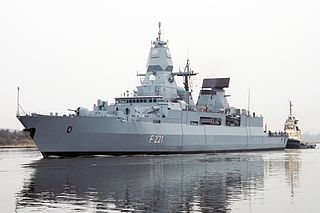
The F124 Sachsen class is the German Navy's latest class of highly advanced air-defense frigates. The design of the Sachsen-class frigate is based on that of the F123 Brandenburg class but with enhanced stealth features designed to deceive an opponent's radar and acoustic sensors. The class incorporates an advanced multifunction radar APAR and a SMART-L long-range radar which is purported to be capable of detecting stealth aircraft and stealth missiles.

HNoMS Horten (A530) was a Norwegian support vessel built at Karljohansvern in Horten, the city from which the ship was named, in 1977. She was in service with the Royal Norwegian Navy until her retirement in 2008 and filled a number of roles while in service.

The Admiral Gorshkov class is a class of frigates of the Russian Navy. The ships are being built by the Severnaya Verf in Saint Petersburg at a cost of $250 million per ship. The class, designated by Russia as Project 22350, was designed by the Severnoye Design Bureau and incorporates use of stealth technology. As of August 2020, ten vessels have been ordered for delivery by 2027. The lead ship of the class, Admiral Gorshkov, was commissioned on 28 July 2018.

The Type 056 corvette is a class of warship deployed by the Chinese People's Liberation Army Navy (PLAN). They replace older patrol craft and some of the Type 053H frigates. The first Type 056 entered service in February 2013. An anti-submarine warfare (ASW) variant, commonly known as Type 056A, has also entered service. Following construction of the Aba in December 2019, China ceased building of Type 056 corvettes to focus on procuring bigger warships for high sea missions.
At least two ships of the Royal Norwegian Navy have been named HNoMS Trondheim, after the city of Trondheim:
Allied Forces South Norway (SONOR) was a NATO command tasked with the defense of Southern Norway. SONOR's area of responsibility included all of Norway with the adjacent sea territory excluding the three northernmost counties of Norway, which were under Allied Forces North Norway.
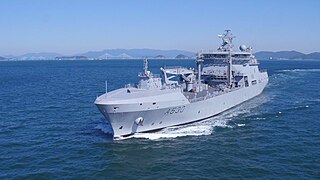
HNoMS Maud is a replenishment oiler constructed at Daewoo Shipbuilding & Marine Engineering in South Korea. She was built on behalf of the Norwegian Defense Materials Agency Forsvarsmateriell, for service in the Royal Norwegian Navy.

















